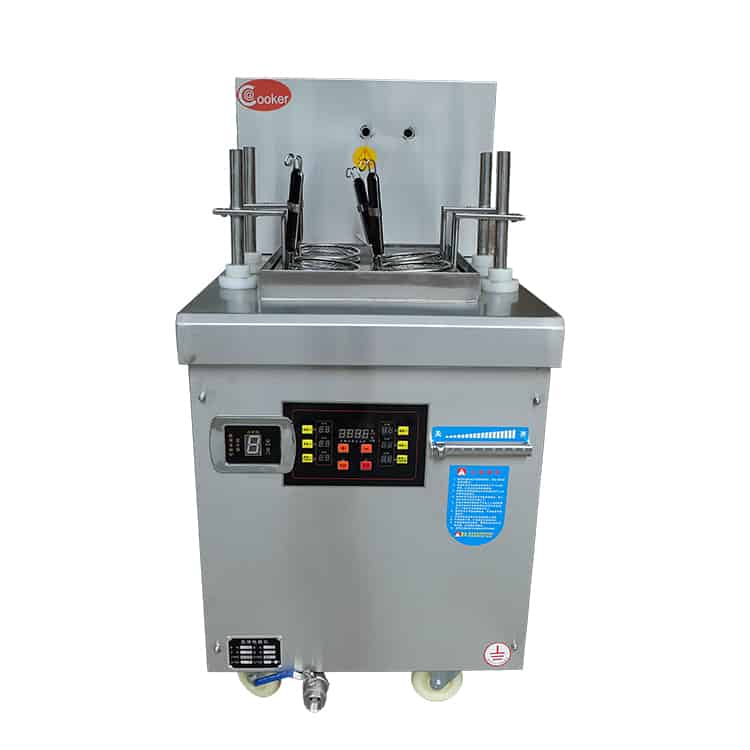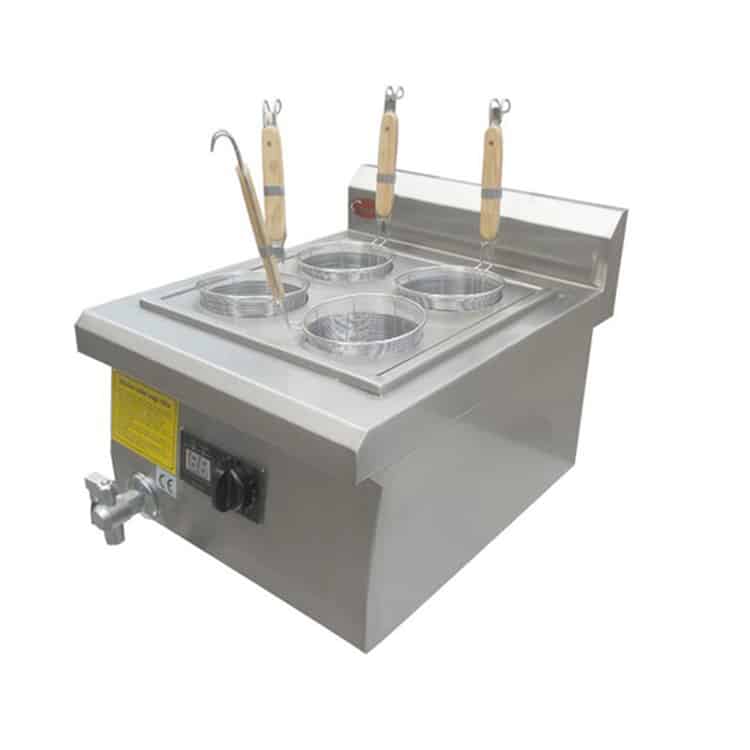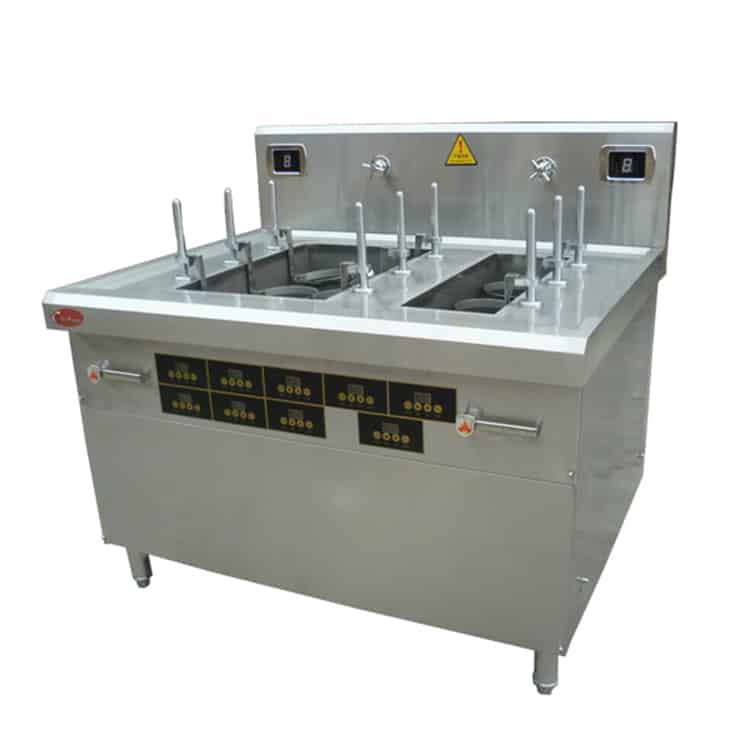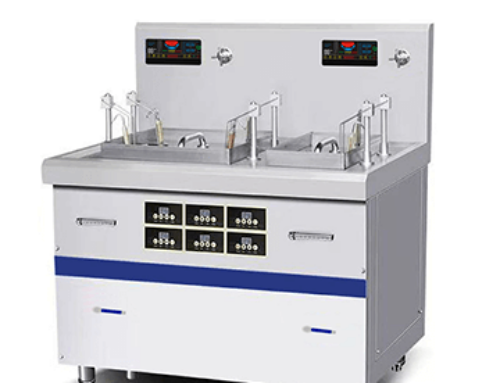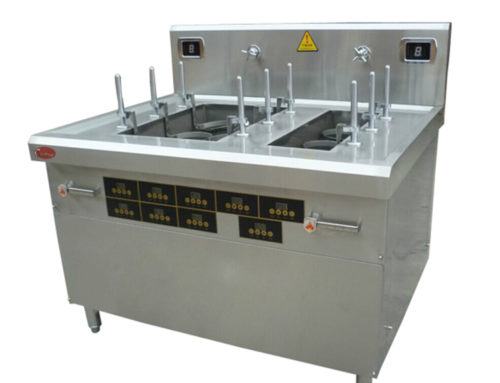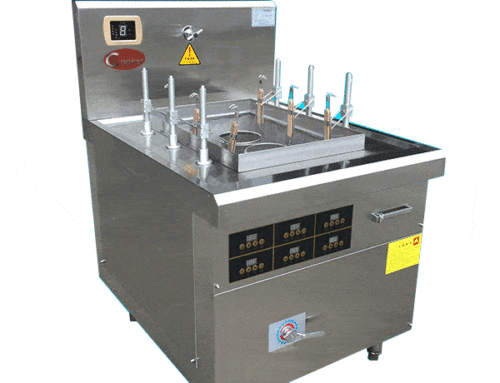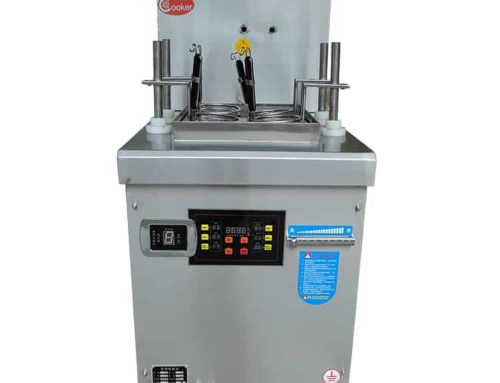How Long to Boil Pasta Noodles? A Complete Guide for Commercial Kitchens
Boiling pasta noodles to perfect al dente texture is critical for customer satisfaction—overcooked pasta becomes mushy, while undercooked noodles are tough. The answer to “how long to boil pasta noodles” depends on factors like pasta type, thickness, and freshness—but most commercial kitchens rely on consistent timing and tools like a pasta cooker to avoid guesswork. AT Cooker’s commercial pasta cookers (from 5KW tabletop models to 15KW automatic boilers) maintain precise boiling temperatures and include timers to ensure consistent results. Below, we break down cooking times for every pasta type, share pro tips for perfect pasta, and explain how a commercial pasta cooker streamlines the process.
1. Most Pasta Noodles Boil in 8 to 12 Minutes
Dried pasta—the most common type in commercial kitchens (e.g., spaghetti, penne, fettuccine)—typically takes 8 to 12 minutes to boil to al dente. This range accounts for standard thickness and shape, and it’s the sweet spot for balancing texture and flavor.
AT Cooker’s ATT-APST-C5B table top pasta cooker (5KW) is designed for this timing: it includes an 8–12 minute preset timer and maintains a steady 212°F (100°C) boiling temperature—critical for consistent results. A café in Chicago uses this model for penne pasta: “We set the timer to 10 minutes, and every batch comes out al dente. No more checking pasta every 30 seconds.”
Key tips for this time range:
- Use 4–6 quarts of water per pound of pasta (AT Cooker’s 23L capacity cookers fit 5–6 pounds per batch).
- Add 1–2 tablespoons of salt per gallon of water to enhance flavor (do not add oil—it prevents sauce from sticking).
- Stir pasta once after adding to water to prevent clumping (AT Cooker’s cookers have built-in stirring aids for large batches).
2. Thin Pasta like Angel Hair Cooks in About 2 to 4 Minutes
Thin, delicate pastas (angel hair, capellini, vermicelli) cook much faster than standard varieties—only 2 to 4 minutes. Their small diameter means water penetrates quickly, so overcooking is a major risk.
AT Cooker’s ATT-APSD-A4 automatic pasta cooker includes a “thin pasta” preset (3 minutes) to avoid mistakes. A Italian restaurant in Miami uses this for angel hair: “We used to overcook angel hair 20% of the time—now the cooker shuts off automatically at 3 minutes. It’s saved us $50/month in wasted pasta.”
Pro tip for thin pasta: Add it to boiling water after reducing the heat to a gentle simmer (not a rolling boil). This prevents the noodles from breaking apart—AT Cooker’s cookers have adjustable heat settings to support this.
3. Fresh Pasta Generally Requires Less Boiling Time, Around 2 to 3 Minutes
Fresh pasta (homemade or store-bought, e.g., ravioli, tortellini, fresh fettuccine) has higher moisture content, so it cooks in just 2 to 3 minutes. Unlike dried pasta, fresh varieties do not need to rehydrate—they only need to heat through and soften.
A hotel kitchen in Las Vegas uses AT Cooker’s ATT-APSD-A6 pasta boiler machine (15KW) for fresh ravioli: “We make 20 pounds of fresh ravioli daily—this cooker boils them in 2.5 minutes, and the automatic basket lift drains them immediately. No more overcooked filling.”
Warning: Do not use dried pasta cooking times for fresh pasta—cooking fresh pasta for 8 minutes will turn it into a mushy mess. Always check fresh pasta at the 2-minute mark.
| Pasta Type | Boiling Time (Al Dente) | Key Notes | Ideal AT Cooker Model |
|---|---|---|---|
| Dried Spaghetti/Penne/Fettuccine | 8–12 minutes | Standard thickness; stir once after adding | ATT-APST-C5B (Table Top, 5KW) |
| Thin Pasta (Angel Hair/Capellini) | 2–4 minutes | Gentle simmer; avoid rolling boil | ATT-APSD-A4 (Automatic, 5KW) |
| Fresh Pasta (Ravioli/Tortellini) | 2–3 minutes | Heat through only; drain immediately | ATT-APSD-A6 (Boiler, 15KW) |
| Large Pasta (Linguine/Tagliatelle) | 9–13 minutes | Thicker strands; check at 9 minutes | ATT-APSD-A9 (Cooking Equipment, 15KW+8KW) |
| Stuffed Pasta (Manicotti/Cannelloni) | 10–14 minutes | Dense filling; boil uncovered | ATT-APSD-A6 (Boiler, 15KW) |
4. Cooking Time Varies Based on Pasta Thickness and Shape
Pasta shape and thickness directly impact boiling time—thicker, denser shapes need more time to cook through. For example:
- Thin, short shapes (orzo, ditalini): 7–9 minutes (small size cooks fast).
- Thick, long shapes (linguine, tagliatelle): 9–13 minutes (thicker strands need more heat).
- Stuffed shapes (manicotti, cannelloni): 10–14 minutes (dense filling slows cooking).
AT Cooker’s ATT-APSD-A9 pasta cooking equipment addresses this with 8 power levels and customizable timers: “We cook 4 different pasta shapes daily—this cooker lets us set unique times for each,” said a restaurant chef in Seattle. “Linguine gets 11 minutes, orzo gets 8—no more one-size-fits-all mistakes.”
Thin Pasta (Angel Hair)
Fastest cooking time
Dried Pasta (Spaghetti)
Most common range
Stuffed Pasta (Cannelloni)
Longest cooking time
5. Boil Pasta in Plenty of Salted Water for Best Results
The amount of water and salt used to boil pasta directly impacts texture and flavor—skimping on either leads to subpar results. Commercial kitchens should use 1 gallon of water per pound of pasta (4 quarts) to ensure the water stays boiling when pasta is added (adding pasta cools water, and a large volume recovers heat faster).
AT Cooker’s pasta cookers have optimized water capacities: the 23L ATT-APST-C5B fits 5 pounds of pasta with 10 gallons of water, while the 40L ATT-APSD-A6 fits 10 pounds. “Our old pot only held 2 gallons of water—adding pasta dropped the temperature to 180°F, and cooking time doubled,” said a diner owner. “The AT Cooker maintains 212°F even with 5 pounds of pasta.”
Salt is equally important: add 1 tablespoon of salt per gallon of water (2 tablespoons for 2 gallons). This seasons the pasta from the inside out—sauce alone can’t replicate this flavor. A test by a culinary school found that salted pasta has 30% more flavor than unsalted pasta, even with the same sauce.
— Marco, Italian Restaurant Owner (Seattle, WA)
6. Al Dente Pasta Is Achieved by Cooking Noodles Until Firm to the Bite
Al dente—Italian for “to the tooth”—means pasta is firm when bitten but not crunchy. It’s the gold standard for pasta, as it holds sauce better and has a more satisfying texture. To achieve al dente:
- Cook pasta to 1–2 minutes less than the package’s maximum time (e.g., 9 minutes for a package that says 10–12 minutes).
- Remove a noodle and bite into it—there should be a small, white “core” in the center (this core will soften as the pasta rests).
- Drain pasta and toss with sauce immediately—residual heat will cook the core to perfect al dente.
AT Cooker’s pasta cookers include “al dente” presets that subtract 1 minute from standard times. A catering company uses this feature: “We cook 10 pounds of pasta for events— the al dente preset ensures it’s perfect when we serve it, even if there’s a 5-minute wait.”
7. Overcooking Pasta Leads to Mushy Texture and Loss of Flavor
Overcooked pasta loses its structural integrity—it becomes mushy, sticky, and unable to hold sauce. It also releases starch into the water, making the water cloudy and the pasta taste bland. Even 1–2 minutes of extra cooking can ruin a batch.
Common causes of overcooking in commercial kitchens:
- Using too little water (water cools too much, and cooking time increases).
- Forgetting to set a timer (distracted by other tasks).
- Not draining pasta immediately (residual heat continues cooking).
AT Cooker’s automatic pasta cookers solve this with automatic basket lifts (ATT-APSD-A6, ATT-APSD-A9) that raise pasta out of water as soon as the timer ends. “We used to overcook 15% of our pasta because we couldn’t drain it fast enough,” said a hotel chef. “Now the cooker lifts the basket automatically—no more mushy spaghetti.”
8. Using a Pasta Cooker Can Help Maintain Consistent Boiling Temperature
Traditional pots struggle to maintain a steady boiling temperature when adding large batches of pasta—adding 5 pounds of pasta can drop water temperature by 20–30°F, doubling cooking time. Commercial pasta cookers like AT Cooker’s models use powerful heating elements (5KW to 15KW) to recover heat in seconds.
The ATT-APSD-A6 pasta boiler machine (15KW) has a “rapid recovery” feature: “We add 8 pounds of pasta at once, and the water is back to boiling in 30 seconds,” said a large restaurant in Chicago. “With our old pot, it took 5 minutes—cooking time went from 10 to 15 minutes, and pasta was mushy.”
Consistent temperature also ensures even cooking—no more undercooked noodles in the center of the pot and overcooked ones on the edges.
Why AT Cooker Pasta Cookers Prevent Temperature Drops
- High-power elements: 5KW–15KW heating systems recover heat 3x faster than residential stoves.
- Insulated tanks: 3-layer insulation keeps water hot, reducing energy waste and temperature fluctuations.
- Digital temperature control: Monitors water temp every 2 seconds and adjusts heat automatically.
- Large water capacity: 23L–40L tanks hold enough water to absorb pasta’s cold temperature without dropping below 200°F.
9. Check Pasta Package Instructions for Specific Cooking Times
While general guidelines work for most pasta, package instructions are tailored to the manufacturer’s thickness and drying process. For example:
- A thin spaghetti brand may recommend 7–9 minutes (shorter than the standard 8–12 minutes).
- A thick whole-wheat penne brand may recommend 12–14 minutes (longer than standard).
A café in Denver uses package instructions with AT Cooker’s customizable timers: “We stock 5 different pasta brands—each has unique times. The cooker’s 8 power levels let us adjust for each, so every batch is perfect.”
Pro tip: Keep a cheat sheet of package times near your pasta cooker for quick reference—this reduces mistakes during busy service.
10. Stir Noodles Occasionally to Prevent Sticking During Boiling
Pasta releases starch as it cooks, which can make noodles stick together—especially in large batches. Stirring once after adding pasta and once halfway through cooking prevents clumping. For commercial-sized batches (5+ pounds), use a long-handled spoon or tongs to gently separate noodles.
AT Cooker’s larger models (like the ATT-APSD-A9) have built-in stirring arms that rotate slowly during cooking. “We cook 10 pounds of pasta at once—without the stirring arm, it would stick into a big clump,” said a stadium concession manager. “Now we don’t have to hire someone just to stir pasta.”
Do not add oil to the water to prevent sticking—oil coats the pasta and prevents sauce from adhering. Stirring is the only effective, sauce-friendly way to avoid clumps.
11. Drain Pasta Promptly After Boiling to Stop Cooking Process
Pasta continues to cook even after being removed from heat—residual heat in the noodles and water can add 1–2 minutes of extra cooking time. To prevent overcooking, drain pasta immediately when the timer ends, and do not let it sit in colanders.
AT Cooker’s automatic pasta cookers have built-in drains and basket lifts to speed this up: “The ATT-APSD-A6 lifts the pasta and drains it in 10 seconds,” said a catering company owner. “With our old colander, it took 2 minutes—pasta was always overcooked by then.”
For cold pasta dishes (e.g., pasta salad), rinse drained pasta with cold water to stop cooking and remove excess starch. This is the only time rinsing is recommended—for hot dishes, rinsing washes away flavor and starch that helps sauce stick.
12. Rinsing Pasta Is Generally Not Recommended Unless for Cold Dishes
Rinsing hot pasta with water removes the thin layer of starch that helps sauce cling to noodles. For hot dishes like spaghetti with marinara or fettuccine Alfredo, skip rinsing—toss drained pasta with sauce immediately to coat it evenly.
A Italian restaurant in New York tested this: “We used to rinse all pasta to ‘clean’ it, but our sauce slid off. Now we skip rinsing, and customers say the sauce tastes ‘creamier’ and ‘more flavorful.’”
Exception: For cold pasta salads, rinse with cold water to stop cooking and prevent clumping. This is the only scenario where rinsing improves the final dish.
13. Cooking Times May Slightly Vary Depending on Altitude and Water Hardness
Two factors can alter pasta boiling times in commercial kitchens:
- Altitude: At elevations above 3,000 feet, water boils at temperatures below 212°F (e.g., 203°F at 5,000 feet). Lower boiling temperatures mean longer cooking times—add 1–2 minutes for every 3,000 feet.
- Water hardness: Hard water (high mineral content) can slightly speed up cooking by conducting heat better—reduce time by 1 minute. Soft water may slow cooking—add 1 minute.
AT Cooker’s customer support team helps adjust timer settings for altitude: “We’re in Denver (5,280 feet), and AT Cooker’s team told us to add 2 minutes to our pasta times,” said a café owner. “Now our pasta is al dente, even with the lower boiling point.”
Get a Pasta Cooker Tailored to Your Boiling Needs
Share your daily pasta volume and menu—we’ll recommend a pasta cooker with the right timer and temperature settings for perfect results.
